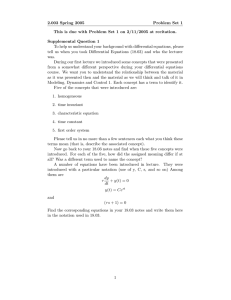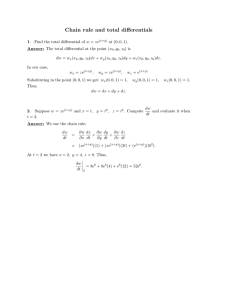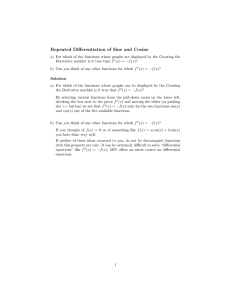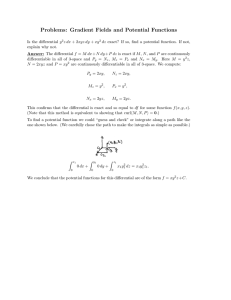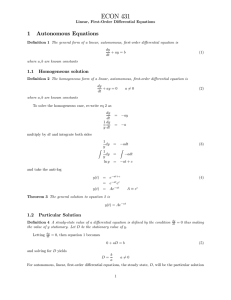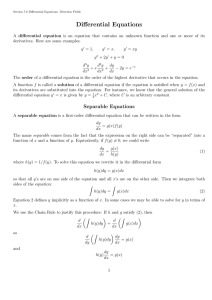Introduction to Ordinary Differential Equations
advertisement
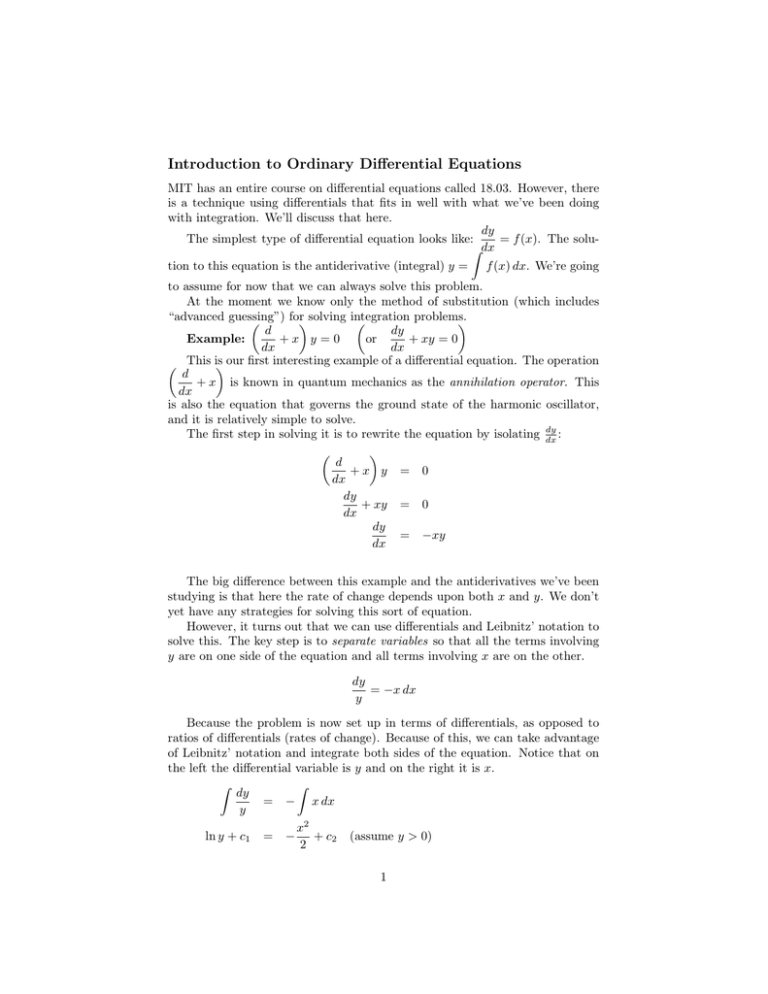
Introduction to Ordinary Differential Equations MIT has an entire course on differential equations called 18.03. However, there is a technique using differentials that fits in well with what we’ve been doing with integration. We’ll discuss that here. dy The simplest type of differential equation looks like: = f (x). The solu­ � dx tion to this equation is the antiderivative (integral) y = f (x) dx. We’re going to assume for now that we can always solve this problem. At the moment we know only the method of substitution (which includes “advanced guessing”) for�solving integration problems. � � � d dy Example: +x y =0 or + xy = 0 dx dx � This is � our first interesting example of a differential equation. The operation d + x is known in quantum mechanics as the annihilation operator. This dx is also the equation that governs the ground state of the harmonic oscillator, and it is relatively simple to solve. dy The first step in solving it is to rewrite the equation by isolating dx : � � d +x y = 0 dx dy + xy = 0 dx dy = −xy dx The big difference between this example and the antiderivatives we’ve been studying is that here the rate of change depends upon both x and y. We don’t yet have any strategies for solving this sort of equation. However, it turns out that we can use differentials and Leibnitz’ notation to solve this. The key step is to separate variables so that all the terms involving y are on one side of the equation and all terms involving x are on the other. dy = −x dx y Because the problem is now set up in terms of differentials, as opposed to ratios of differentials (rates of change). Because of this, we can take advantage of Leibnitz’ notation and integrate both sides of the equation. Notice that on the left the differential variable is y and on the right it is x. � � dy = − x dx y x2 ln y + c1 = − + c2 (assume y > 0) 2 1 x2 + c (we only need one constant c = c2 − c1 ) 2 ln y = − eln y y = = ec+−x /2 2 ec e−x /2 y 2 = Ae−x 2 /2 (A = ec ) 1 Y 0.8 0.6 0.4 0.2 0 −6 −4 −2 0 2 4 6 X Figure 1: Graph of y = e− x2 2 . 2 It turns out that the solution is y = ae−x /2 for any constant multiple a, � 0. We can check this solution using differentiation: despite the fact that ec = y dy dx = = = 2 ae−x /2 d −x2 /2 ae dx 2 ae−x /2 · −2x/2 (chain rule) 2 = ae−x /2 · −x = y · −x dy dx = −xy 2 dy This matches the equation for dx from our first step, so y = ae−x /2 is a solution to our differential equation. We didn’t make any assumptions about a in this calculation, so this is a solution no matter what value a has; a = 0 is possible along with all a = � 0, depending on the initial conditions. For instance, if 2 2 y(0) = 1, then y = e−x /2 . If y(0) = a, then y = ae−x /2 (See Fig. 1). 2 This function is known as the normal distribution, which you may recognize from probability. In quantum mechanics it helps describe where a particle is. The aim of differential equations is to solve them. Just as with algebraic equations. Usually, differential equations are telling you something about the balance between an acceleration and a velocity; for example, if you’re doing cal­ culations involving air resistance. Sometimes in applied problems, formulating a differential equation to describe a situation is very important. In order to see that you chose the right formulation you must confirm that your solution fits what actually happens in the real world. 2 Question: How can y = ae−x /2 be our final solution when we don’t know what a is? 2 Answer: We call y = ae−x /2 the general solution; in other words, the whole family of solutions we get by choosing different values for a is the answer to the question. � � d Frequently we will be given more information than just + x y = 0. dx For example, we might know that when x is 0, y is 3. Given that extra piece of information, we can nail down exactly which function is the solution: y = ae−x 2 3 = ae−(0 3 = ae /2 2 )/2 0 3 = a 2 And so the final solution would be y = 3e−x /2 . If we don’t have the information you need to restrict our answer to a single function then the solution is not one function, it’s a family of functions described by the different possible values of some parameter like a. Question: Can you solve for x instead of y? Answer: Sure! You would get the inverse function of the function that we’re officially looking for but yes, it’s legal. Sometimes we’ll have to make do with just an implicit formula and sometimes we’re stuck with x is a function of y. The way in which the solution is specified can be complicated; as you’ll soon see, it’s not necessarily the best thing to think y as a function of x. 3 MIT OpenCourseWare http://ocw.mit.edu 18.01SC Single Variable Calculus�� Fall 2010 �� For information about citing these materials or our Terms of Use, visit: http://ocw.mit.edu/terms.

